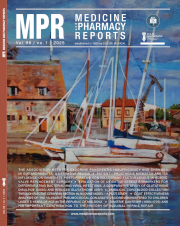Dimitrie Cantemir (1683-1723) and his important contribution to the history of inguinal hernia repair
DOI:
https://doi.org/10.15386/mpr-2683Keywords:
history of surgery, inguinal hernia, transabdominal repairAbstract
In 2023 we celebrated 350 years since the birth, and 300 years since the death of Dimitrie Cantemir (1673-1723), scholar of European prominence, encyclopedic spirit, Prince of Moldavia, first Romanian member of the Berlin Academy of Sciences, and the first in Eastern Europe. Cantemir described for the first time the transperitoneal approach to inguinal hernia repair in his famous work “The History of the Growth and Decay of the Othman Empire”. The work was written in Latin, revised in 1714-1716 and translated into English by N. Tindal and published in 1734. We briefly present a history of the main existing therapeutic procedures for inguinal hernia repair until the Cantemir’s presentation. The description of the procedure is in “Annotationes”, in the chapter entitled “Avlonia”, a region from Albania. The Albanians were famous for their skill in repairing inguinal hernias. Cantemir witnessed a hernia repair performed on his secretary in his palace in Istanbul. He gives a detailed description of the procedure, the abdominal incision, reduction of hernial sac content, closing and cauterizing of the hernial orifice with the preservation of the testicle, and the evolution of the patient during the 30 days of follow-up. The postoperative mortality was 1-2%. The surgical technique presented was a progress towards the operations practiced at the time in Europe, mainly cautery and castration. The history of inguinal hernia repair is a mirror of surgical history. The presentation of the transperitoneal approach of the inguinal hernia by the Romanian scholar is of a great importance for the history of surgery and medicine.
Downloads
Published
How to Cite
Issue
Section
License
The authors are required to transfer the copyright of the published paper to the journal. This is done by agreeing to sign the Copyright Assignment Form. Whenever the case, authors are also required to send permissions to reproduce material (such as illustrations) from the copyright holder.

The papers published in the journal are licensed under a Creative Commons Attribution-NonCommercial-NoDerivatives 4.0 International License.

